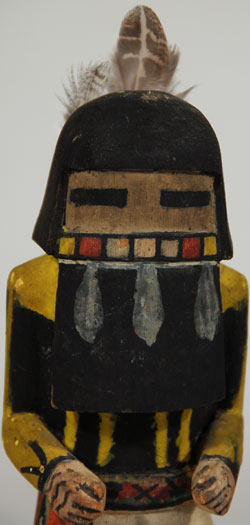Hopi Angak’china (Long Hair) Katsina Doll [SOLD]
+ Add to my watchlist Forward to Friend
- Category: Traditional
- Origin: Hopi Pueblo, Hopituh Shi-nu-mu
- Medium: cottonwood root, paint
- Size: 7-1/4” tall
- Item # C3297B SOLD

The Long Hair Katsina is a singer of sweet songs who brings rain and flowers. His beard and loose tassels of feathers symbolize rain and clouds. They appear as dancers in a group at Niman and at plaza dances with manas. Their purpose is to bring rain, and it is said that they seldom dance without the appearance of a soft gentle rain.
The Long Hair is danced from the Rio Grande to the Hopi Mesas in almost the same form. Among the Hopis there are many varieties but the regular Angak'china is the one shown here. They appear in a group and sing a very melodious song which may be one of the reasons that they are such favorites.
They are often used for the Niman Katsina on First Mesa coming with the Köcha Mana. In fact, they have danced in late August on First Mesa in direct contradiction to the feeling that only Masau'u can be danced out of season. This is probably due to the fact that the Hopi-Tewa populate First Mesa and have no restrictions to such appearances.
Condition: This carving of Angak'china probably dates to the 1940s and is in very good condition. The front of both feet have been broken off and repaired.
Provenance: from a gentleman from Wisconsin
Reference: Kachinas: A Hopi Artist's Documentary by Barton Wright
- Category: Traditional
- Origin: Hopi Pueblo, Hopituh Shi-nu-mu
- Medium: cottonwood root, paint
- Size: 7-1/4” tall
- Item # C3297B SOLD



